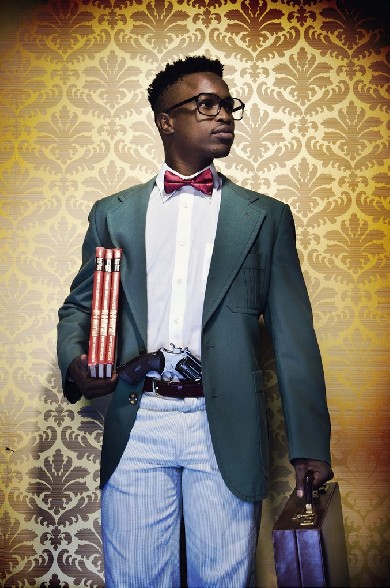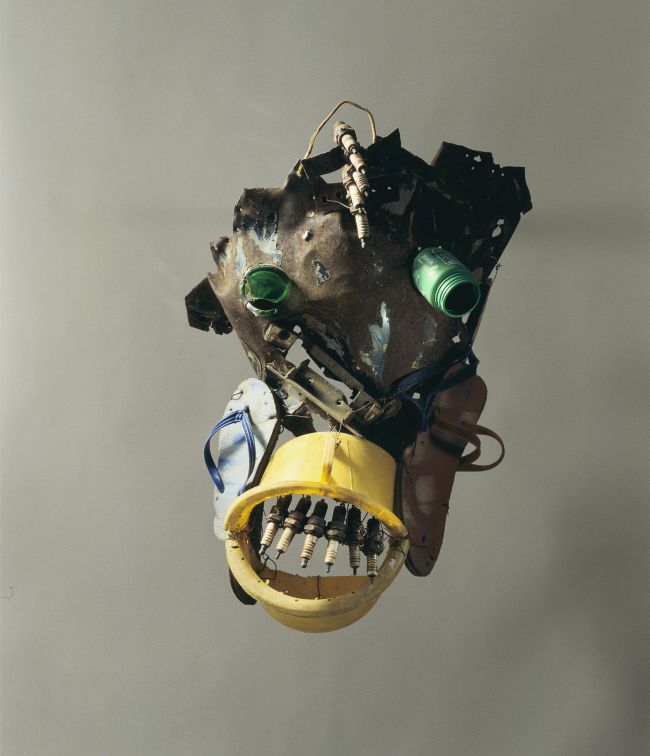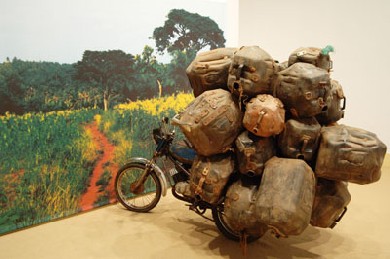
Exhibition with work from the Pigozzi Collection in Harvard Art Museums, Ethelbert Cooper Gallery of African & African American Art.
Review of Holland Cotter (NYT, November 20, 2014):
A New Destination for African Art
‘Luminós/C/ity.Ordinary Joy’ Opens the Cooper Gallery at Harvard
CAMBRIDGE, Mass. — A few weeks before the revamped Harvard Art Museums reopened here, a new university-affiliated art space, the Ethelbert Cooper Gallery of African & African American Art, made its debut in modest quarters, two former storefront offices off Harvard Square, filling a slot that other local institutions left all but empty. The raw spaces were unpromising, to say the least, but the architect David Adjaye has done miracles in linking them and carving out eight nichelike galleries for the first show, “Luminós/C/ity.Ordinary Joy: From the Pigozzi Contemporary African Art Collection,” for which he also served as curator along with Mariane Ibrahim-Lenhardt.

Romouald Hazoumé, On/Off.
The Pigozzi collection itself comes with problems. Assembled by the French collector Jean Pigozzi over the past two decades, it has been accused of having a neo-primitivist bias: Its stated preference is for African art that’s academically untutored art and free of international influences. An essay in the exhibition catalog by the art historian Christa Clarke discusses that issue, though by now the collection is so vast, with more than 10,000 pieces, as to encompass African work of almost every type. In any case, the curators, working with the Cooper director, Vera Ingrid Grant, finesse the matter with a varied selection of 21 artists and by taking urbanism, and by extension cosmopolitanism, as a theme.

Chiurai Kudzanai, The Minister of Education, 2009.
A tabletop model of an imaginary city made from scrap paper and plastic by Bodys Isek Kingelez, from the Democratic Republic of Congo, starts the show on a fantastic but ambiguous note: Is it a vision of the new African city as a utopia or as a multinational vanity project? Whatever the answer, there’s no question that continent’s street life continues to be vital, as is evident in casual photographs from the 1950s through 1970s by the Angolan-born Jean Depara and in videos by the Cameroonian artist Pascale Marthine Tayou today.
 Calixte Dakpogan, La Mort Debout, 2002.
Calixte Dakpogan, La Mort Debout, 2002.
Almost as consistently, top-down politics are inescapable, as the young Zimbabwean artist Kudzanai Chiurai learned when he came under attack for making a satirical photographic portrait of the country’s president, Robert Mugabe.
Now in exile in South Africa, Mr. Chiurai also turned to film. His 2012 video “Iyeza,” in which the Last Supper is both the backdrop to and generator of military violence, is an exhibition standout, along with a suite of large ballpoint-pen-and crayon drawings of flying machines — they look like baroque drones — by Abu Bakarr Mansaray, from Sierra Leone.
 Abu Bakarr Mansaray, The Digital Man, 2006.
Abu Bakarr Mansaray, The Digital Man, 2006.
Inexplicably, there’s just one woman, Nandipha Mntambo, from South Africa, with a video in which she appears — for good reason, it would seem, given her isolation — as a toreador making bullfighting moves in an empty ring. And a sculpture by Titos Mabota, from Mozambique, wraps the show up where it started, with ambiguity and questions. His piece, of a giant bicycle constructed of scrap wood and rope, is an emblem of self-propelled movement, progress and possibility held in suspension.

Hazoumé, Roulette Beninoise, 2005.
Sponsored by the Hutchins Center for African & African American Research and its founder Henry Louis Gates Jr., the Cooper Gallery holds a lot of promise, and has a stimulating program planned. Next up, an historical show of work by the now largely forgotten Afro-Cuban art and political movement called Grupo Antillano (1978-83), organized by Alejandro de la Fuente, a professor of Latin American history and African-American studies at Harvard.
“Luminós/C/ity.Ordinary Joy: From the Pigozzi Contemporary African Art Collection” runs through Jan. 8 at the Ethelbert Cooper Gallery of African & African American Art, 102 Mount Auburn Street, Cambridge, Mass.
